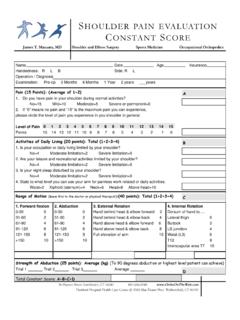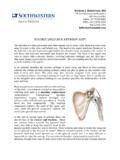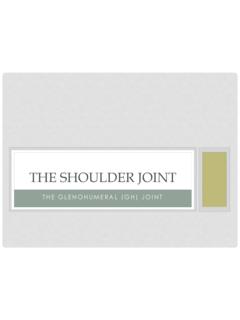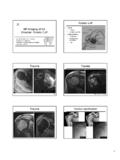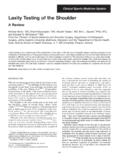Transcription of James T. Mazzara, MD The Diagnosis and …
1 James T. Mazzara, MDConnecticut Center for Orthopedic Surgery, LLC860-649-2267 The Diagnosis and Management of shoulder Pain29 Haynes StreetManchester, CT 060401260 Silas Deane HwyWethersfield, CT 06109-Age-Extremity Dominance-History of trauma, dislocation, subluxation-Weakness, numbness, paresthesias-Sports participation-Past medical history (Diabetes, thyroid disease, cancer)-Previous history of joint problems (Rheumatoid disorders)-Stiffness, Range of motion limitation-Night pain (Continuous or related to position)-Occupation, position of arm when working-Aggravating factors-Alleviating factors-Previous treatment (Therapy, NSAIDs, surgery)-Pain location - anterior arm, upper arm, superior shoulder , interscapular-History of malignancySignificant HistorySignificant shoulder Examination-Observation (swelling, atrophy, deformity)-Tenderness localized to bursa, AC joint, glenohumeral joint-Range of motion (active & passive) in planes of elevation, external rotation, internal rotation, cross body adduction-Provocative tests for impingement & instability-Motor & sensory upper extremity assessment-Non-contributory cervical spine exam-NB: exam should be bilateral and each side compared for symmetry-Distal upper extremity examination (Check reflexes)Significant Imaging-True AP in internal and external rotation-Axillary view-Lateral in scapular plane-If concerned about impingement syndrome -Outlet view -Caudally tilted AP (25 degrees)Critical Exclusionary Diagnoses-Acute trauma (fracture, dislocation, AC separation)-Tumor-Infection-Referred pain from cervical spine, chest, abdomenExclusionary DiagnosisNeeds specialized careDifferential Diagnosis1.
2 Rotator Cuff Disorders2. Frozen Shoulder3. Glenohumeral Instability5. Acromioclavicular Joint Disorder4. Arthritis of Glenohumeral JointContinue treatment if expertise availableRefer to SpecialistNoYesRefer to page 2 SLAP lesions, types 1 through 4 Modified from and based upon the AAOS Dept of Research and Scientific Affairs on shoulder PainJames T. Mazzara, MDConnecticut Center for Orthopedic Surgery, LLC860-649-2267 The Diagnosis and Management of shoulder Pain29 Haynes StreetManchester, CT 060401260 Silas Deane HwyWethersfield, CT 06109 Rotator Cuff DisordersAge usually > 40yrs. Weakness, atrophy, tendernessPainful arc of motionNight painImpingement signsUpper arm painPainful crepitationX-rays may be normal or may demonstratethe following:-Acromial spur-Greater tuberosity sclerosis &/or cysts-Loss of acromiohumeral intervalAge < 30 upper arm painNo weaknessNo impingement signsFrozen ShoulderProgressive pain and stiffness of spontaneous onsetLoss of ROM in all planesNo localized tendernessPain at end rangeNon-specific x-raysMay show osteopeniaNormal range of motion of shoulderGlenohumeral InstabilityAge usually <40 of dislocation or subluxation, Apprehension sign and relocation tests (tests for shoulder instability)Generalized ligamentous laxityHill-Sachs deformityAnterior inferior glenoid calcificationX-rays may be normalNo history of dislocation or subluxation, no apprehension or relocation testsGlenohumeral Joint ArthritisAge usually > 50 painKnown arthritis ( RA)
3 Tender GH joint posteriorlyCrepitusDecreased ROMH umeral osteophytesHumeral head flatteningIrregular or narrow joint spaceBone cystsNormal ROMN ormal x-raysAcromioclavicular Joint DisorderAC joint deformityAC joint tendernessPain with cross-body adductionSuperior clavicular painIrregular or narrowed joint spaceLysis or sclerosis of distal clavicleNo swelling or tenderness of AC jointRank Differential Diagnoses1O Diagnosis ConfirmedNeedsSpecialized CareContinue if expertise availableRefer to SpecialistFindingsConsistentwithDiagnosi sPlainX-rayFindingsFindingsInconsistentw ithDiagnosisPlain x-ray series Impingement Series-True AP (Grashey) view in internal rotation-True AP (Grashey) view in external rotation-Transaxillary view-Outlet view-25O caudally tilted viewImpingement Series-True AP (Grashey) view in internal rotation-True AP (Grashey) view in external rotation-Transaxillary view-Outlet view-25O caudally tilted viewInstability Series-AP view- True AP (Grashey)-Scapulolateral Y-view-Transaxillary viewMay also need the following views:-West Point view-Stryker notch view-Velpeau axillary viewGH DJD Series-True AP (Grashey) view-Transaxillary lateral-Outlet viewImpingement series plus-AP of AC joint -Zanca (15 degree cephalic tilt) view-Trans axillary lateralAdditionalstudiesConsider MRI early for acute weakness or for chronic pain and/or weakness not responding to appropriate nonsurgical treamentMRI is of no value in diagnosing frozen shoulder which should be diagnosed by history, examinationand negative x-ray arthrogram is more valuable than plain MRI in the evaluation of labral pathology such as SLAP oBankart scan with 3D reconstructions may be helpful in assessing glenoid or humeral head damage and glenoid of arthritis should be made on plain x-ray alone.
4 MRI may be helpful in evaluating the integrity of the rotator cuff but is usually nonecessary. CT scan is helpful in determining glenoid version and posterior wear of the and CT scan are usually not necessary to evaluate conditions of the AC joint relatedto arthritis, osteolysis or from and based upon the AAOS Dept of Research and Scientific Affairs on shoulder PainJames T. Mazzara, MDConnecticut Center for Orthopedic Surgery, LLC860-649-2267 The Diagnosis and Management of shoulder Pain29 Haynes StreetManchester, CT 060401260 Silas Deane HwyWethersfield, CT 06109 Rotator Cuff DisordersSeverity of ProblemSevere: Marked or sudden loss of strength manifested by either drop arm sign or loss of active elevation, loss of external rotation strengthManageable: ADL function without sudden loss of strengthRefertoSpecialistInitial Treatment (3-6 weeks)Activity modificationNSAIDs unless contraindicatedROM and strengthening exercises -Stretching to restore full elevation and rotation -Posterior capsular stretching -Strengthen rotator cuff and scapular stabilizers after ROM is restoredResponseto treatmentActivities as toleratedReturn as neededReview initial assessment and treatment compliance (history, physical exam, x-ray data)Rule out other diagnosesConsider a subacromial injectionFrozen ShoulderInitial treatment 3-4 weeks(However, patients with diabetes or hyperthyroidism may require more prolonged treatment)
5 Activity modificationNSAIDs unless contraindicatedExercise program -Stretching to restore full elevation and rotation -Posterior capsular stretching -Strengthen rotator cuff and scapular stabilizers after ROM is restoredResponsetoTreatmentGood ResponseRestoration of full range of motion -ADL -Work related tasks -SleepModified Treatment (3-4 weeks)NSAIDsActivity modificationSupervised physical therapyResponsetoSecondTreatmentPartial or Poor Response to TreatmentIncomplete or not maintained improvement in pain, motionstrength or ADLM inimal or no restoration of activitiesInability to workPatient dissatisfied with outcomeActivities as toleratedReturn as neededReview initial assessment and treatment, compliance (history, physical exam, x-ray data)Rule out other diagnosesAppropriate Initial Assessment andTreatment ComplianceNeeds Specialized CareRefertoSpecialistAcromioclavicular Joint Disorder-Osteoarthritis-OsteolysisInitia l Treatment 3-4 weeksActivity modificationNSAIDsCorticosteroid injection if appropriateResponsetoTreatmentGlenohumer al InstabilityPatientRequiringReduction ofDislocationRefertoSpecialistInitial Treatment 3-4 weeks-Proper period, technique and position of immobilization-Post immobilization physical therapy for selective muscle strengtheningResponsetoTreatmentActivity as toleratedReturn as neededGlenohumeral ArthritisInitial Treatment 3-4 weeksActivity modificationNSAIDsROM and Strengthening exercises-Stretching to improve forward flexion, extension and rotation-Posterior capsular stretching-Strengthen deltoid, rotator cuff and scapular stabilizers as ROM is improvingAppropriateInitialResponse toTreatmentReview initial assessment and treatment compliance (history.)
6 Physical examination and x-ray data)Rule out other diagnosesModify NSAIDsAppropriateTreatmentandComplianceS evereManageableGoodPartial/PoorYesNoGood PartialGood ResponseRestoration of full range of motion -ADL -Work related tasks -SleepPartial or Poor Response to TreatmentIncomplete or not maintained improvement in pain, motion, strength or ADLM inimal or no restoration of activitiesInability to workPatient dissatisfied with outcomeReview initial assessment and treatment compliance (history, physical examination and x-ray data)Rule out other diagnosesModify NSAIDsAppropriate Initial Assessment andTreatment ComplianceYesNoGoodPoor or PartialYesGoodPartial or PoorGoodPartial or PoorYesRepeat or Continue initial treatmentNoModified from and based upon the AAOS Dept of Research and Scientific Affairs on shoulder Pai
